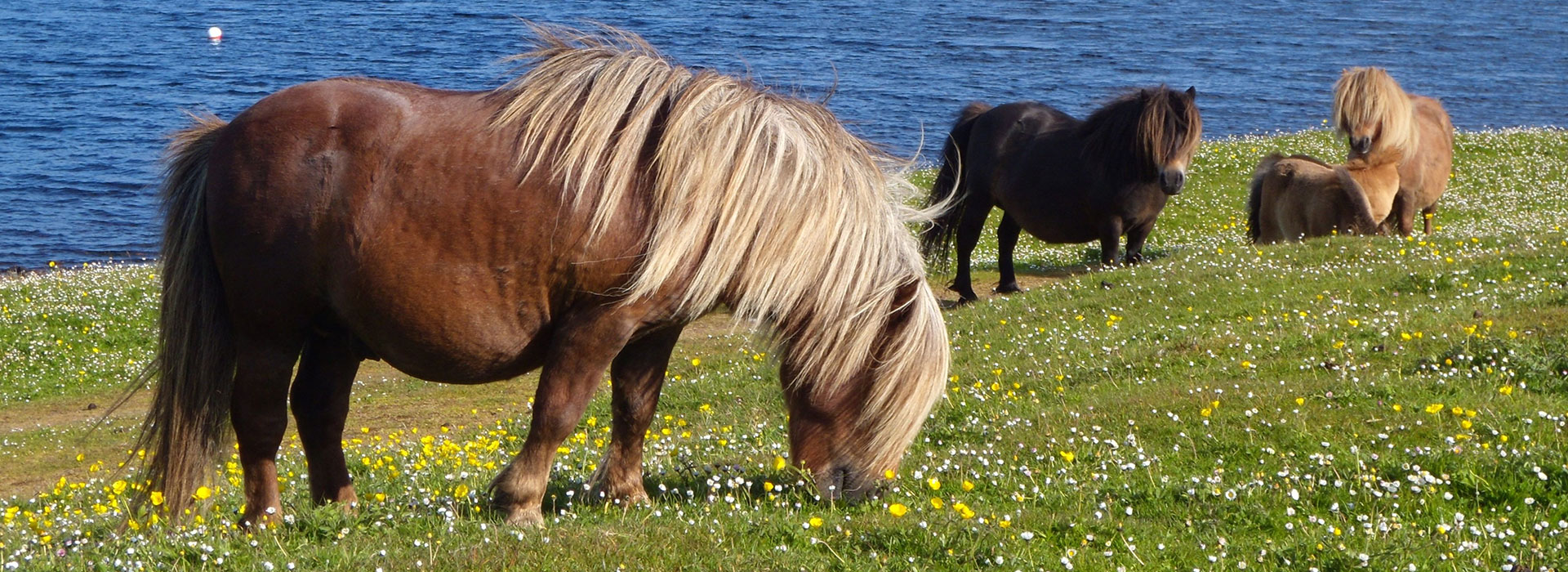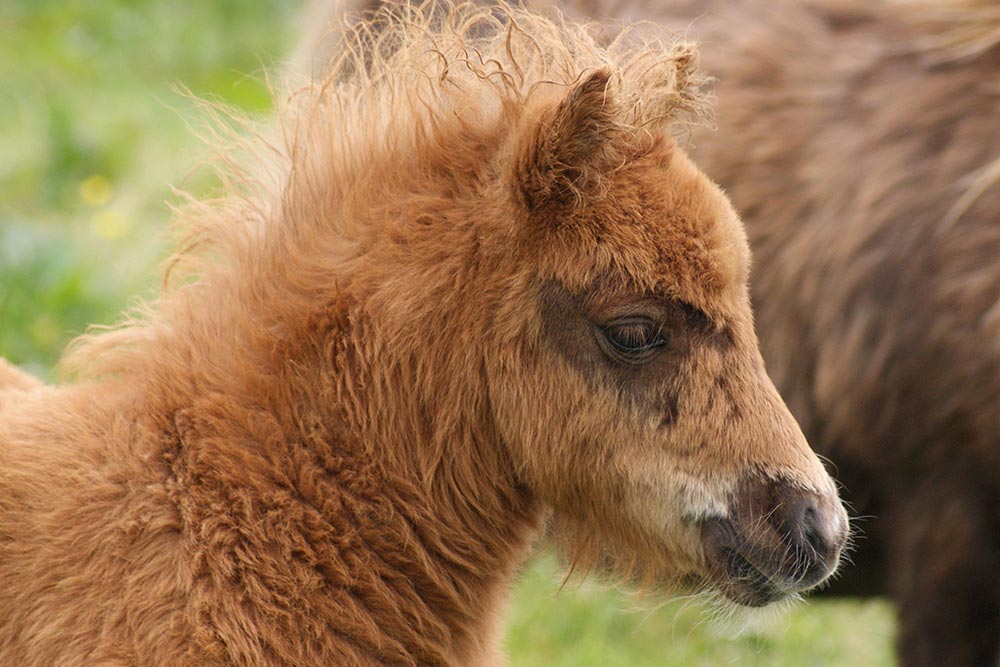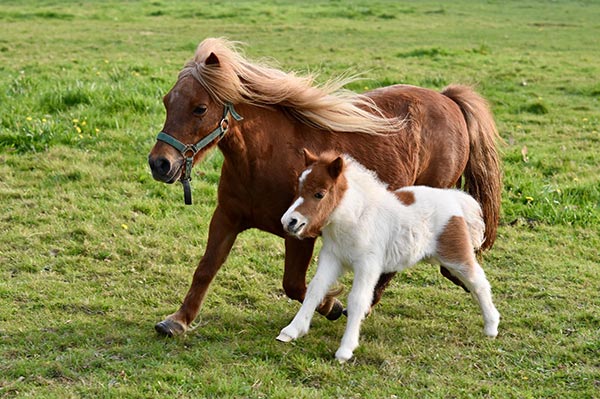Registrations
Important information
Due to new regulations, previous registration forms are no longer in use. New registration forms are available from the office.
Silhouette drawings must be completed when registering foals.
Please ensure that you complete the silhouette using red ink for white markings before submitting your registrations forms.
On-line registrations are no longer available. This facility has been withdrawn as incompatible with new regulations. Registration forms are only available from the office and photocopies are not acceptable.
Please select a link for an example of a completed form for both solid and broken coloured ponies.

Shetland ponies are issued with a Stud-Book number when the breeder registers the pony. This number remains with the pony throughout its life. When a filly has her first foal, a colt is registered as a gelding, or a colt successfully passes the Voluntary Veterinary Examination to become a stallion, an additional mare, gelding or stallion number is added to the pony’s record.
(Ponies born before 1991 will not have been allocated a number at birth and will only have acquired a Stud-Book number on having a first foal, being registered as a gelding or licensed as a stallion.)
Passports issued by the SPSBS combine the pony’s registration document as well as the required pages for passport legislation.
Please note that Registrations and Passport legislation are a separate issue. (Please see Passports).
Downloads
Legal Responsibilities of Owners in Relation to Equine Passports
Prefix
Voluntary Vetting
FOAL REGISTRATIONS
New government deadlines have been introduced for submitting passport applications.
All foals must be passported by 31st December in the year of birth or by the time they are 6 months old, whichever is later.
Applications must now be with the office by November 30th.
Applications for foals born later in the year must now be with the office by the time the foal is 5 months old.
Late registrations will be accepted but will incur an additional fee and passports issued will be marked “DUPLICATE”.
Registration of foals sired by an unlicensed colt will also incur an additional fee.
Foals that are registered with the Society will receive a combined Registration and Passport document providing the required fees have been paid.
If you wish you may register your Shetland pony with the Shetland Pony Stud-Book Society but obtain a passport from another passport issuing organisation. However this passport will not contain any of the registration and pedigree details about your pony. Foal names must be a maximum of 40 digits long including any prefix and spaces, apostrophes etc.
Categories for Foal Registrations are:
Mares with First Foal
When a filly has her first foal registered with SPSBS, she will need to be registered as a mare and will then be allocated a mare number. An entry recording her as a mare will be made in the Stud-Book for that year. A fee is payable for the mare’s registration as well as for the foal. Please return your first foaling mare’s passport to the office so that her new details can be updated.
Mares with Additional Produce
For mares that already have foals registered with SPSBS:
Should you be unfortunate enough to have a stillborn foal, you may still record the birth if you wish. Simply complete the registration form in the usual manner however you need only complete the front of the form. If you wish only to record the birth, you need not name the foal and the Stud-Book entry will show “Dead Foal”. No fee is payable for this unless it is the mare’s first foal, in which case only the mare’s registration fee is payable. If you wish to name the foal, the registration fee will be payable.
Registrations of Ponies 12 Months Old and Over
Registrations will be accepted but all ponies 12 months of age and over are required to be fully DNA parentage tested before being accepted for registration. It may be that one or both parents are already DNA tested – if in doubt please call the Society office – 01738 623471.
DNA from First Foaling Mares
The Society would like to remind breeders that as of 1st January 2024, all first foaling/maiden mares must have their DNA profile completed prior to foal registration. Please bear this in mind when submitting foal registrations as this may mean they take longer to complete. We would encourage breeders to get mares DNA profiled in advance of foal registration.
Coat colour
The following list of colours is acceptable for pony registrations in our studbook. If any member wishes to use a description of a colour not on the list they should first to apply to council who will discuss the matter. Any colours not on the list will be returned for amendment. Please note that the term “Smoky” or “Smokey” is not permitted.
Black
Where black pigment is general throughout the coat, limbs, mane and tail, with no pattern factor present other than white markings.
Brown
Where there is a mixture of black and brown pigment in the coat.
Bays
Bays vary in shade from dull red or brown, to a brighter colour approaching chestnut, but it can be distinguished from the chestnut by the fact that the bay has black on the lower parts of the limbs, a black mane and tail and often black tips to the ears.
Chestnut
This colour consists of a muted orange body varying in intensity from reddish to gold. Depending on the depth of colour, chestnuts can be light, dark/liver or bright. A true chestnut has a chestnut mane and tail which might be lighter or darker than the body colour. Chestnuts may also have flaxen manes and tails.
Grey
Where the body coat is a varying mosaic of black and white hairs, with black skin. With increasing age the coat grows lighter. As there are many variations according to age and season all of them should be described by the general term grey.
PIEBALD
The body consists of large irregular patches of black and white hair.
Skewbald
The body consists of large irregular patches of white and any other definite colour except black.
Palomino
Newly-minted gold coin colour (lighter or darker shades are permissible), with a white mane and tail.
Cremello
Cremello is a horse coat colour consisting of a cream coloured body with a cream or white mane and tail. It occurs when a horse is homozygous for a dilution gene sometimes called the cream gene acting on a red (chestnut) base coat. Such horses have pink skin, blue eyes, and are a light cream or gold colour when born, but sometimes fade to almost white as an adult.
CREAM
As Cremello, but with dark eyes. Coat may vary from very pale cream to dark cream.
PERLINO
Perlino ponies have cream coats with pink skin and blue eyes. The cream colour can vary from a very pale off white to a pale coffee colour. The mane and tail are often darker for perlinos than for cremellos. Perlinos have a base coat colour of bay or brown and are homozygous for the cream dilution gene.
Roans
White hairs throughout the coat give a roan effect. Roans are distinguished by the ground or body colours, all of which are permanent. A basic colour must be given when describing roan e.g. blue roan, strawberry roan, etc. On the limbs hairs of the ground/body colour usually predominate, although white markings may be encountered.
Duns
Duns vary in body colour from cream or light grey to chestnut or brown, but are distinguished by having darker limbs and a dorsal/eel stripe along the back. A basic colour must be given when describing dun e.g. blue dun, cream dun, yellow dun, etc.
Buckskin
Body colour can vary from a creamy golden to rich golden colour with black points, mane and tail. Buckskin ponies are similar to dun ponies in appearance, but lack the dorsal/eel stripe of the dun. Buckskin ponies are the result of a cream dilution gene on a bay pony.
Whorls
Whorls are formed by changes in direction of flow of the hair and should be indicated by a cross ie X
Flesh Marks
These appear normally on the muzzle where skin pigment is absent and should be marked as a solid red area.
Aquired Marks
For example, scars, should be marked within inverted commas on the diagram. Freeze-marks should also be described and their location indicated in the relevant diagram.
Passports
The SPS-BS only issues passports for pure-bred Shetland ponies that are registered with the Society.
Legislation requires that a foal must have a passport by 31st December in the year of its birth or by the time it is 6 months old, whichever is the later. Please note that the society is required to notify the authorities of all late registrations.
The registration form for foals doubles as an application for a passport so there is no need to fill in two separate forms for registering a foal and applying for a passport so long as the correct fee has been paid.
All equines MUST HAVE A PASSPORT and ponies CANNOT BE SOLD without a passport. If you do not have a passport for each of your equines then you may risk a substantial fine or term of imprisonment.
The SPSBS issues a combined passport and registration document for all registered Shetland ponies. This document contains the pony’s registration details, identification, pedigree, microchip number, changes of ownership and medical records.
For this reason the SPSBS encourages owners to obtain their passport from the Society so that all the pony’s details remain with it wherever it is domiciled.
Application forms for passports for ponies which are already registered are available from the office.
If you have a registered Shetland pony but have chosen to obtain a passport from another passport issuer, you should be aware that the passport will not contain verified information about breeding, pedigree etc.
If you have a passport that requires the description to be amended, then there is a fee payable for this – please contact Shetland House for further details.
Voluntary Vetting
It is not obligatory for owners to have male ponies examined but the SPSBS Council recommends that a Voluntary Veterinary Examination is undertaken, before any colt/stallion is used as a breeding animal. The examination must be undertaken by a qualified veterinary surgeon from the approved list, at any time of year and at a location convenient for the colt owner. If there is no veterinary surgeon on the list in your area, please contact the office.
YOU SHOULD ALLOW TWO WORKING DAYS AFTER RECEIPT FOR THE OFFICE TO PROCESS YOUR APPLICATION AND POST THE KIT. PLEASE ALLOW TIME FOR DELIVERY BEFORE MAKING YOUR APPOINTMENT.
All colts born from 2017 onwards must be able to be fully parentage tested. If the sire or dam is not available for testing then the colt will not be eligible for licensing.
The Veterinary Surgeon will micro-chip the colt/stallion if the pony is not already chipped. The Vet will then take a hair sample for DNA testing from the colt/stallion and post it directly to the S.P.S-B.S office. The Veterinary examination is voluntary. Colts failing the Veterinary examination may be re-presented once. The veterinary examination will be undertaken according to the International Veterinary Standard.
All colts/stallions passing the Veterinary examination must not exceed 42″ at 4 years or over.
All colts/stallions brought forward for the Voluntary Veterinary examination, will be asked for DNA hair samples from both parents and themselves. Colts/stallions born before 2017 that are able to comply with the parentage verification will have one of the following denotations:
SPC – Sire Parentage checked
DPC – Dam Parentage checked
SDPC – Sire and Dam Parentage checked
The applicable DNA denotation will be shown in both the colts/stallions passport and relevant stud-book entry.
The ideal situation would be for full parentage testing of colts/stallions used for breeding pedigree Shetland ponies.
If, for any reason, including the following: one or both parents are dead or untraceable or the owners of the parents of the colts/stallions refuse to give a hair sample for DNA testing, this WILL NOT EXCLUDE pedigree registered colts/stallions born before 2017 undergoing a Voluntary Veterinary examination or being used for breeding and all pure-bred progeny that meets the entry criteria for the Mother studbook will be registered from these colts/stallions.
The owner should apply to the office on the relevant form and return this with the current fee to cover DNA typing of the colt/stallion and micro-chipping if necessary.
Please note that the fee payable to the Society does not include the veterinary surgeon’s fees, which must be paid in full by the owner of the colt/stallion directly to the veterinary surgeon.
The office will send the relevant paperwork, DNA kit and microchip, if applicable, to the nominated vet two working days after receipt. The vet will undertake the examination and then return the paperwork directly to the office. The owner will pay the vet’s fees in all cases directly to the vet.
It is the responsibility of the colt/stallion owner to arrange the DNA testing of the colt/stallion’s parents if they have not already been tested, if hair samples are available for DNA testing.
DNA Typing
To DNA test a pony, the relevant fee is submitted to the office along with the sample, which will be sent to the lab.
A hair sample has to be taken, preferably from the mane, ensuring that the roots or follicles are still on the hairs. You may take the sample yourself, it is not necessary to use a vet, (unless a Voluntary Veterinary examination is being undertaken).
If you are asked to provide a repeat sample, this does mean that a further payment must be made and that the results are likely to be delayed.
Once the test has been completed, the lab will provide a number that will be recorded on the pony’s record in the Office.
Ponies need only be tested once in their lifetime unless problems occur which require a further test to be carried out.
The Society reserves the right to use or pass on information regarding blood or DNA samples where appropriate. This applies equally to samples taken privately or at a Stallions Voluntary Vetting Examination, Society Sale etc.
Instructional video – how to take a hair sample
Prefix
All breeders wishing to use a “Stud Name” for registering ponies must seek approval from the Central Prefix Register. This is quite easily done by completing a Prefix form and returning it with the fee of £100.00 to SPSBS who will forward it to the Central Prefix Register on your behalf.
New prefixes must be between 3 and 25 characters long with no spaces, hyphens or apostrophes. Final approval rests with the Central Prefix Register.
To check availability of a particular name look on the Central Prefix website: www.centralprefixregister.com
Extensions of a current prefix are also available. Again simply complete an Extension to Prefix form and return directly to the Central Prefix Register with the correct fee and your certificate. They will then contact the Secretary to seek approval prior to informing the applicant directly.


